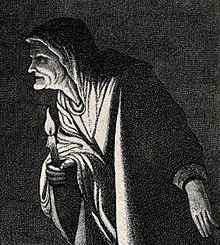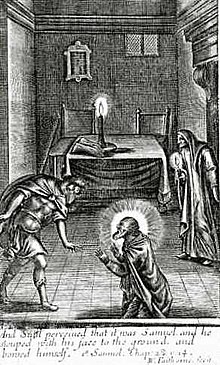Witch of Endor



The Witch of Endor, also known as the Medium of Endor, was a medium who apparently summoned the prophet Samuel's spirit, at the demand of King Saul of the Kingdom of Israel in the First Book of Samuel, chapter 28:3–25. The witch is absent from the version of that event recounted in the deuterocanonical Book of Sirach (46:19–20). She is called in Biblical Hebrew אֵ֥שֶׁת בַּֽעֲלַת־אֹ֖וב בְּעֵ֥ין דֹּֽור (’êšeṯ ba‘ălaṯ-’ōḇ bə-‘Êndōr), "a woman who has a familiar spirit at Endor".
Story
When Samuel dies, he is buried in Ramah. Saul, the current King of Israel, seeks wisdom from God in choosing a course of action against the assembled forces of the Philistines. He receives no answer from dreams, prophets, or the Urim and Thummim. Having driven out all necromancers and magicians from Israel, Saul searches for a medium anonymously and in disguise. His search leads him to a woman of Endor, who claims that she can see the ghost of Samuel rising from the abode of the dead.[1] The voice of the prophet's ghost, after complaining of being disturbed, berates Saul for disobeying God, and predicts Saul's downfall. The spirit reiterates a pre-mortem prophecy by Samuel, adding that Saul will perish with his whole army in battle the next day. Saul is terrified. The next day, his army is defeated as prophesied, and Saul commits suicide.
Although Saul is depicted as an antagonist to witches and diviners, the Witch of Endor generally is portrayed sympathetically; she comforts Saul when she sees his distress and insists on feeding him before he leaves.
The woman is described as "a woman with an ob" (אוֹב, a talisman[2] or perhaps wineskin)[3] in Hebrew, which may be a reference to ventriloquism,[4] and she claims to see "elohim arising" (plural verb) from the ground.
Interpretations
Judaism
The Yalkut Shimoni (11th century) identifies the anonymous witch as the mother of Abner.[5] Based upon the witch's claim to have seen something, and Saul having heard a disembodied voice, the Yalkut suggests that necromancers are able to see the spirits of the dead but are unable to hear their speech, while the person for whom the deceased was summoned hears the voice but fails to see anything.[6]
Christianity
The Church Fathers and some modern Christian writers have debated the theological issues raised by this text. The story of King Saul and the Medium of Endor would appear at first sight to affirm that it is possible for humans to summon the spirits of the dead by magic.
In the Septuagint (2nd century BCE) the woman is described as a "ventriloquist",[7] possibly reflecting the consistent view of the Alexandrian translators concerning "demons... which exist not".[8] However Josephus (1st century) appears to find the story completely credible (Antiquities of the Jews 6,14).

Medieval glosses to the Bible suggested that what the witch actually summoned was not the ghost of Samuel, but a demon taking his shape or an illusion crafted by the witch.[9] Martin Luther, who believed that the dead were unconscious, read that it was "the Devil's ghost", whereas John Calvin, who did believe in the immortal soul, read that "it was not the real Samuel, but a spectre."[10]
Mortalist denominations, such as Seventh-day Adventists, generally teach that the story is an example of ancient witchcraft or sorcery in the Bible.[citation needed]
Spiritualism
Spiritualists have taken the story as evidence of spirit mediumship in ancient times. The story has been cited in debates between Spiritualist apologists and Christian critics. "The woman of Endor was a medium, respectable, honest, law abiding, and far more Christ-like than" Christian critics of Spiritualism, asserted one Chicago Spiritualist paper in 1875.[11]
In popular culture
The witch appears as a character in oratorios (including Mors Saulis et Jonathae (c. 1682) by Charpentier, In Guilty Night: Saul and the Witch of Endor (1691) by Henry Purcell, Saul (1738) by Handel on the death of Saul, and Le roi David (1921) by Honegger), and operas (David et Jonathas (1688) by the afore-mentioned Charpentier and Saul og David (1902) by Carl Nielsen).
A year after the death of his son at Loos, Rudyard Kipling wrote a poem called "En-Dor" (1916), about supposed communication with the dead.[12] It concludes,
Oh the road to En-dor is the oldest road
And the craziest road of all!
Straight it runs to the Witch’s abode,
As it did in the days of Saul,
And nothing has changed of the sorrow in store
For such as go down on the road to En-dor!
The Martha Graham Dance Company premiered The Witch of Endor in 1965 at the 54th Street Theater in New York. A one-act work, it had choreography and costumes by Martha Graham, music by William Schuman, sets by Ming Cho Lee, and lighting by Jean Rosenthal.
In Endor by Shaul Tchernichovsky, describing King Saul's encounter with the Witch of Endor, is considered a major work of modern Hebrew poetry. Tchernichovsky particularly identified with the character of Saul, perhaps due to his own name, and the poem expresses considerable empathy to this King's tragic fate.
References
- ^ Geza Vermes (2008) The Resurrection. London, Penguin: 25–6
- ^ Emil G. Hirsch Jewish Encyclopedia 1911 Endor, the witch of
- ^ Blueletterbible.org
- ^ The International Standard Bible Encyclopedia p307 ed. Geoffrey W. Bromiley – 1959 "... of 'ob (RSV "medium"). According to one view it is the same word that means a "bottle made out of skins" ("wineskin," Job 32:19). The term would then refer to the technique of ventriloquism or, more accurately, "belly-talking".
- ^ Yalḳ, Sam. 140, from Pirḳe R. El.
- ^ Emil G. Hirsch Jewish Encyclopedia 1911 Endor, the witch of
- ^ Hans-Josef Klauck, Brian McNeil Magic and paganism in early Christianity: the world of the Acts of the Apostles p66 2003 "A classical example is King Saul's visit to the 'witch' of Endor. The Septuagint says once that the seer engages in 'soothsaying' and three times that she engages in 'ventriloquism' (1 Sam 28:6–9)."
- ^ Milian Lauritz Andreasen Isaiah the gospel prophet: a preacher of righteousness 2001 p345"The Septuagint translates: They "burn incense on bricks to devils which exist not."
- ^ "Necromancy". Catholic Encyclopedia. Retrieved 5 Sep 2012.
- ^ J. M. Buckley. Faith Healing, Christian Science and Kindred Phenomena. p. 221 2003, "The witch of Endor – The account of the "Witch of Endor is the only instance in the Bible where a description of the processes and ... Luther held that it was "the Devil's ghost"; Calvin that "it was not the real Samuel, but a spectre. "
- ^ "The Religion of Ghosts." Spiritualist At Work, Vol. 1, No. 19. April 24, 1875. (Chicago.) p. 1
- ^ Tonie Holt, Valmai Holt My Boy Jack: The Search for Kipling's Only Son (1998), p. 234. "Desperate as they were, there is no evidence that Rudyard and Carrie ever contemplated trying to reach John in this way and Rudyard's scorn for those who did was expressed in the poem En-dor, written the following year."
External links
- Medium of Endor: From the Jewish Encyclopedia
